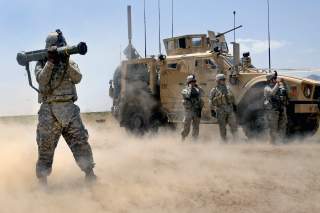Can the Army Get Ready for War with Russia and China and Fight Terror Too?
The challenge of our times: too many challenges?
The United States Army will receive increased funding in the President’s fiscal year 2019 budget proposal as the service struggles to modernize while simultaneously fighting wars in current conflicts. The problem the Army must solve is how to deter Russia and China while dealing with today’s challenges.
“The Army supports the 2018 National Defense Strategy by providing a combat-credible war-fighting force, postured and capable of deterring global competitors, preventing conflict and shaping the global security environment,” Maj. Gen. Paul A. Chamberlain, Army budget director told reporters. “The revisionist powers of China and Russia, the rogue regimes, such as Iran and North Korea, along with transnational threat organizations, particularly terrorist groups, pose a broad range of very real threats to U.S. interests. Our regional competitors in the Pacific and in Europe have been studying our strengths and our vulnerabilities for more than a decade. Their modernization efforts are slowly eroding our competitive advantage, and this budget request addresses that, by providing the necessary resources to ensure the Army's superiority.”
Recommended: America Has Military Options for North Korea (but They're All Bad)
Recommended: 1,700 Planes Ready for War: Everything You Need To Know About China's Air Force
Recommended: Stealth vs. North Korea’s Air Defenses: Who Wins?
Chamberlain summed up the basic problem the service faces. “The Army must be able to, if necessary, win in a multi-domain battlefield, a battlefield that requires integrated capabilities in fires, cyber, electronic warfare and space, and be capable of striking the enemy and improving friendly survivability against a sophisticated enemy in a contested environment,” Chamberlain said. “The Army's role and the nation's ability to maintain peace through strength requires us to refocus and strengthen our force-on-force decisive action capability, maintain our counter-insurgency competencies for the current fight, and develop superior capabilities for warfare in all domains.”
The fiscal year 2019 budget should help the Army meet its goals. “With this budget submission, the Army continues its efforts to become more lethal, resilient and ready in order to face current and future threats,” Chamberlain said. “The budget themes listed represent the framework from which the Army will provide the combatant commands the best trained and ready land forces in the world.”
One of the key features of the Army budget is the war on terrorism. “This budget request funds ongoing counter-terrorism and counter-insurgency operations around the globe,” Chamberlain said. “It also funds counter-terrorism and counter-insurgency training, ensuring the competencies mastered over the past decade and a half of fighting are sustained.”
But the budget also funds high-end warfighting capability. “The resources applied in this budget for additional end strength will increase unit readiness levels and support the creation of select units to acquire necessary capabilities, taking significant steps towards increasing Army's warfighting readiness and increasing the Army's capacity for force-on-force decisive action,” Chamberlain said. “This budget request funds modernization reform initiatives that will increase the Army's agility and lethality, providing for more timely, efficient and cost-conscious modernization of critical platforms and infrastructure.”
The Army has six modernization priorities in this budget proposal. “In fiscal year '19, the Army will continue to empower cross-functional teams to champion the six modernization priorities: long-range precision fires, next generation combat vehicles, future vertical lift, the Army network, air and missile defense and soldier lethality, in order to bring new and emerging technology to the battlefield sooner,” Chamberlain said. “Ultimately, these modernization efforts will allow the Army to expand technological overmatch and competitive advantage against near-peer competitors and prepare for other emerging threats, resulting in a more lethal combined arms force that is capable of responding rapidly to a global crisis.”
Dave Majumdar is the defense editor for The National Interest. You can follow him on Twitter: @davemajumdar.
Image: Flickr

